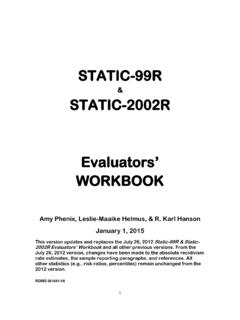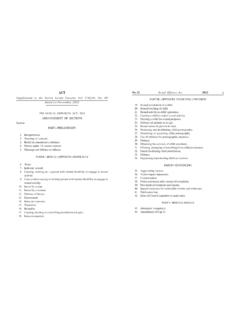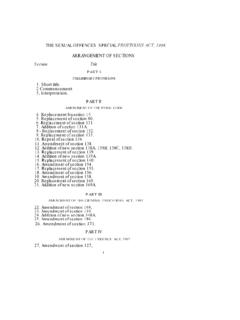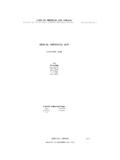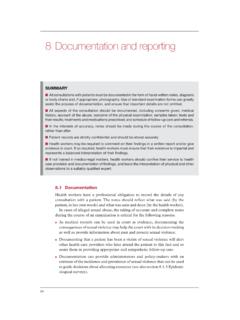Transcription of APPLICATION FOR APPROVAL OF TOPIC AND FORMAT
1 Assessing the risk of sexual offenders on community supervision: The Dynamic Supervision Project 2007-05 R. Karl Hanson, Andrew J. R. Harris, Terri-Lynne Scott and Leslie Helmus Public Safety Canada Cat. No.: PS3-1/2007-5 ISBN No.: 978-0-662-69992-7 Table of Contents Executive ii Method ..3 Subjects ..3 Measures ..7 Static risk factors ..7 Stable risk Acute risk factors ..8 Combining static, stable and acute Procedure ..9 Data collection ..9 Recidivism ..11 Overview of Stable variables ..13 Combining stable Analysis of stable Acute variables ..20 Discussion ..25 1. STABLE-2000 Tally Sheet ..35 2. Rules for combining static and stable factors ..36 3. Distribution of stable risk factors (first assessment) ..37 4.
2 STABLE-2007 Tally Sheet ..38 5. Three year recidivism rates for Static/Stable-2000 original 6. Three year recidivism rates for Static/Stable-2000 revised 7. Three year recidivism rates for Static/Stable-2007 ..41 8. sexual recidivism rates for Static/Stable-2007 risk categories ..42 9. Violent and general recidivism rates for Static/Stable-2007 risk categories ..43 10. Predictive accuracy across sub-groups ..44 11. Distribution of acute risk factors (all assessments)..50 12. ACUTE-2007 Tally 13. Rules for combining static, stable and acute risk factors ..52 14. Relative risk for recidivism within 45 days based on combined Static-99, Stable-2007 and acute scores ..53 Executive summary sexual offenders do great societal damage causing justifiable public concern. Over the past 10 years psychology has developed techniques to reliably sort male sexual offenders into low, moderate, and high risk for sexual recidivism (MnSOST-R, Risk Matrix-2000, RRASOR, STATIC-99, STATIC-2002) based upon historical, static, non-changeable risk factors.
3 The static structure of these tests effectively precludes their ability to measure changes in risk. The STABLE-2007 and the ACUTE-2007 are specialized tools designed to assess and track changes in risk status over time by assessing changeable dynamic risk factors. Stable dynamic risk factors are personal skill deficits, predilections, and learned behaviours that correlate with sexual recidivism but that can be changed through a process of effortful intervention . Should effortful intervention (read: treatment or supervision) take place in such a way as to reduce these risk-relevant factors there would be a concomitant reduction in the likelihood of sexual recidivism. Acute dynamic risk factors are highly transient conditions that would only last hours or days.
4 These factors are rapidly changing environmental and intrapersonal stresses, conditions, or events that have been shown by previous research to be related to imminent sexual reoffence. These instruments should be used to inform correctional managers as to how much risk they are managing, to inform decisions on levels of community treatment and supervision, and estimate changes in risk status pre and post treatment or other interventions. The Dynamic Supervision Project involved every Canadian province and territory and the states of Alaska and Iowa in a robust test of risk assessment methodologies. A total of 156 parole and probation officers completed repeated 3-level (static, stable & acute) risk assessments on 997 sexual offenders across 16 jurisdictions.
5 All of the probation and parole officers scoring risk of reoffence for these community-based sexual offenders were trained in sexual offender risk assessment by attending a two-day training that focussed on scoring actual case examples. sexual , violent and other recidivism information was gathered from official criminal histories after a median of 41 months of follow-up. The sexual recidivism rate for this widely disparate group of community-based sexual offenders was after three years (n = 790). The STABLE-2007 and the ACUTE-2007 are easier to score than their predecessors and combinations of the STATIC-99 and STABLE-2007, scored by all contributing officers, produced ROC (receiver operating characteristic) values for sexual reoffence of.
6 76 and .72 for violent reoffence. When used by conscientious officers the STATIC-99/STABLE-2007 combined scores produced an ROC for sexual reoffence of .84 and .80 for violent recidivism. STABLE-2007 and ACUTE-2007 assessments were found to add predictive power above and beyond that available to assessments of static risk alone. This study provides evidence that trained community supervision officers can reliably score valid and useful sex offender risk assessments. Results of this nature, even taking into account the need for replication and cross-validation, suggest significant policy and practice implications for the community supervision of sexual offenders. i Acknowledgements Although only four authors appear on the title of this manuscript, this study would not have been possible without the contributions of many people, most importantly the 156 community supervision officers who took time from their already busy schedules to submit data to this project.
7 Special thanks are due to the following for their help with training, implementation and/or data collection: Tim Astle, Alexandrine Chevel, Randy Cole, Jean-Louis Cormier, Susan Cox, Lisa Ginter, Luke Gregory, Carla Ground, Uwe Jensen, Claudia Levesque, Eileen McWade, Donna-Lee Rabey-McKay, Patricia Ratel, Amanda Scorrar, Alan Shoom, Mark Stehlin, Danielle Paris and Karl Williams. Helpful comments on the report and the measures were provided by David Thornton, Ruth Mann and Yolanda Fernandez. We would also like to thank the following PS research staff for all their work on this multi-year project: Jennifer Cooney, Erik Gaudreault, Shannon Hodgson, Shelley Price and Kimberly Smallshaw.
8 Thanks to all. We hope that we have merited your trust by providing information that promotes safe and just community supervision of sexual offenders. ii Introduction sexual offences are among the crimes that provoke the most public concern. A number of policies have been developed to address this concern, including sex offender registries, specialized treatment programs and long-term supervision orders. A fundamental assumption of all these initiatives is that community supervision of sexual offenders can reduce their risk of reoffending. Supervision can only reduce risk, however, when it monitors and addresses factors related to recidivism. The available research has identified a number of factors associated with the long-term recidivism rates of sexual offenders (Hanson & Bussi re, 1998; Hanson & Morton-Bourgon, 2005).
9 By using combinations of these factors, evaluators can differentiate between those offenders who have a substantial probability (greater than 50%) of being apprehended for a new sexual offence and those offenders who rarely reoffend (less than 10% probability; Hanson & Thornton, 2000). The factors currently used to predict long-term recidivism potential are mainly static, historical variables, such as the number of prior sexual offences and victim characteristics. Such unchangeable, static factors cannot be used to measure changes in risk levels nor to determine how or when to intervene. To measure change, evaluators require knowledge of dynamic (changeable) risk factors. There are two types of dynamic factors worth considering: a) stable dynamic factors, which are potentially changeable but endure for months or years ( , alcoholism, intimacy deficits), and b) acute dynamic factors, which can change over a period of weeks or days, even hours, and signal the timing of new offences ( , drunkenness, acute distress).
10 Many of the important decisions made by community supervision officers are based on dynamic risk factors (amenability to supervision, timing of revocation). Research on dynamic risk factors, however, is much less developed than the research on static factors. Consequently, evaluators assessing sexual offenders on community supervision are often forced to make decisions based on factors that may or may not be related to recidivism ( , behaviour during treatment ). The current study aimed to advance risk assessment for sexual offenders by identifying the dynamic risk factors for sexual offenders on community supervision, and by presenting a method by which static, stable and acute factors can be combined into an overall evaluation of risk.







